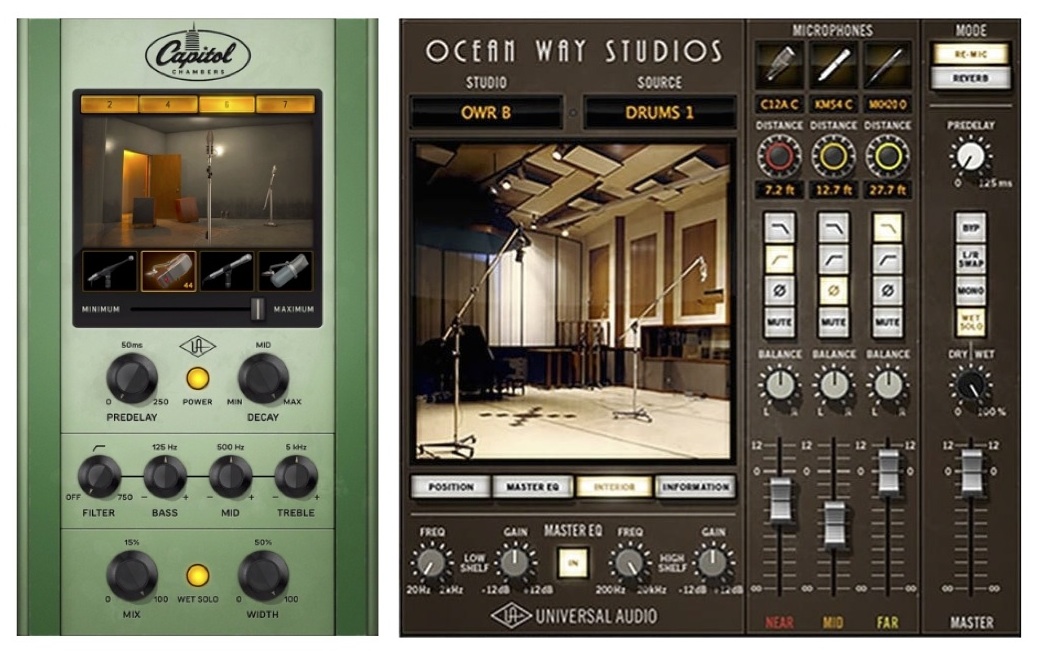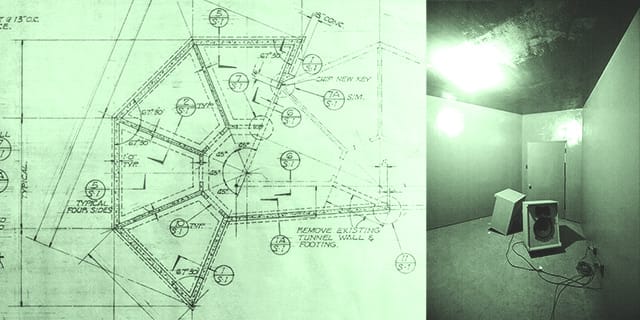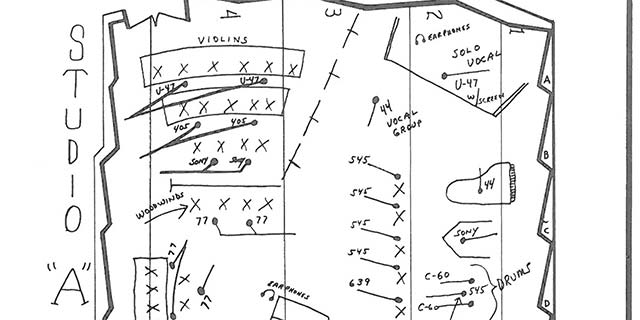New Software Review: Capitol Chambers & Ocean Way Studios by Universal Audio

Universal Audio captures the essence of two of music’s most historic rooms with the Capitol Chambers and Ocean Way Studios plugins.
Recent developments in the world of reverb have pushed far beyond the once impressive convolution technology we’ve grown accustomed to.
In particular, I’ve become fascinated by what Universal Audio is doing with their proprietary Dynamic Room Modeling (DRM) and the plugins that employ it.
Their new Capitol Chambers and previous release, Ocean Way Studios (each priced at $349) both enable you to manipulate environment with unique parameters that will be very familiar to those used to recording in rooms or using chambers.
For example, I don’t know of another plugin that offers mic selection to change a reverb. While not inexpensive, both plugins are potentially very powerful additions to your reverb arsenal, and I was curious to see if the value offered was commensurate with the cost.
Features
While both plugins use DRM, the implementation is not identical. For instance, with Capitol Chambers you can only select 1 type of mic (out of 4 options) to act as the stereo pair while Ocean Way Studios enables you to simultaneously select up to 3 different microphone pairs (11 different microphones modeled), and a highly-functional mixer to blend them.
Each of the 3 studio microphones has its own volume, pan, polarity, mute, high-pass filter, and low-pass filter. The only limitation with the 3 microphones is that the minimum and maximum distance for each is limited so that the first can only be a near mic, the second only a mid mic, and the third only a far mic. Capitol Chambers has 1 slider to set the mic distance from the speakers. There are also some similar features between the 2 plugins.
Both offer you pre-delay. Ocean Way gives you fully variable range from 0-125 ms, and Capitol gives you fully variable range from 0-250 ms. They also both include a Wet/Dry knob and a Wet Solo button to keep the ambience at 100% wetness despite the knob’s placement.
EQ is a valuable addition to both plugins. Capitol offers you 3 bands, a fixed 125 Hz Baxandall style low shelf, a fixed 500 Hz mid band with proportional Q, and a fixed 5 kHz Baxandall style high shelf. Additionally included is a sweepable (80-750 Hz) 6 dB low-cut filter that minimizes muddy frequencies entering the chamber. Ocean Way offers a low shelf (20-2000 Hz) and a high shelf (200-20000 Hz), each with +/- 12 dB of gain.

In the creation of Capitol Chambers, UA sourced technical diagrams dating back to the 1960’s to replicate mic and speaker setups.
Only Capitol however supplies a Width knob (0-100%) that enables you to narrow the stereo field, and a Decay knob to set the length of the tail. The decay from the chambers is dramatically longer than the studios, which is something to keep in mind depending on your needs. Ocean Way provides brief room ambience and environment. The Capitol Chambers give you anywhere from a maximum of 5 to 9.5 seconds of decay depending on the chamber (each of the 4 chambers has a different maximum time), all the way down to a minimum of 1 second using the Decay knob.
These 4 chambers also have different speakers modeled, which give each a unique tone. Ocean Way has 2 different studios to choose between, and their decay lengths are not very different.
In Use
Using these tools instead of traditional reverb was very fun, an interesting twist, and ultimately extremely musical in their practice and results. I found myself going to my recording engineer knowledge more often to manipulate the ambience. Instead of changing the diffusion parameter on a typical reverb plugin, I was able to change the microphone distance. It translated to what I heard in my head just as good, if not better, than typical diffusion. Changing microphones instead of going to an EQ made a lot of sense too, and was sonically powerful.
Universal Audio picked a good variety of microphones for both plugins. There was a wide range of sounds available with what they chose. The Ocean Way plugin is special because of the multiple microphones and the powerful mixer that controls each. It was great to be able to filter certain mics for just their low-end, midrange, or top-end. You are also able to create a unique stereo image with the panning options between 3 mic pairs. It sounded special having the heavier mics with more bass towards the middle, and going wider with the more present mics.
Additionally, Ocean Way has 2 modes which provides for more tonal variation and implementation options. 1 mode, “Reverb”, is your traditional reverb that you would put on a send or use wet/dry, and omits the “Direct Path” reverb component. The second mode, “Re-Mic”, gives you a more faithful impression that your source audio was recorded in Ocean Way, and is by nature fully wet where the purpose is to fully “replace” your existing recording. The dry signal is not blended back in with the second mode, but instead processed to inherit the complete sonic characteristics of the studio acoustics, source dispersion patterns, and microphones with more accuracy and realism than is possible with just the late field reverb processing. Lastly, Ocean Way provides source presets to give you the optimal mic choices for that particular sound.![]()
To Be Critical
As much as I had fun and got great musical results, I do wish Universal Audio pushed a little harder to expand the feature set beyond what is realistically possible. There is so much opportunity for plugins to be more powerful than the things they emulate, but that doesn’t seem to be a priority with these tools.
I wish the Width knob on Capitol Chambers, for example, would have gone beyond 100%. Sure, we can put a plugin on after to spread it wider but it would have been great to see that option built in. The pre-delay times are also only set by milliseconds. It would’ve been progressive and useful if UA provided a MIDI Sync option to set the pre-delay by tempo (16th note, 32nd note, etc).
On the Ocean Way plugins as I mentioned, the minimum and maximum mic distances are locked to a certain range depending on if it’s the near, mid, or far selection. I really wish it was just microphone 1, 2, and 3, and you have the full room at your disposal. It would also be useful to have more than 1 close mic, but that’s not currently possible.
The EQ frequencies on Capitol Chambers are fixed besides the low-cut, while on Ocean Way the 2 bands are widely variable with frequency selection. This means it’s evidently possible, but for some reason UA didn’t want that option on Capitol Chambers—I found this a bit disappointing.
Summing it Up
With a $349 price point in mind, my recommendations for Universal Audio’s Capitol Chambers and Ocean Way Studios vary depending on where you fall on the professional to hobbyist spectrum. They sound phenomenal, and the unique parameters put me in a really engaged headspace to tailor my ambience in the most musical fashion. When choosing which plugin to use, it’s important to consider your individual needs for both shorter ambience and long, lush reverbs. Ocean Way Studios and Capitol Chambers each provide different sounds, and having 1 is not the same as having the other.
I don’t think the hobbyist needs these plugins as they are expensive, and for a very long time people did fine without Dynamic Room Modeling. If you are a hobbyist who is curious about these tools and happens to be able to comfortably afford them, I do recommend you demo each and see if you still want to purchase after the 14 days. If you are a professional, I recommend the same—try the demo and see how you can integrate these plugins into your workflow. With the price and sound quality considered, I do believe these plugins are of value to the professional.
Please note: When you buy products through links on this page, we may earn an affiliate commission.







